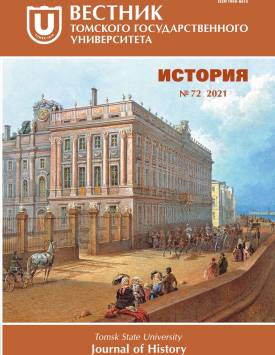Visegrad group: long-term partnership or tactical alliance
The article is devoted to the nature of the Visegrad cooperation. The goal of the article is to analyze the features of the organization define if it is a long-term partnership or tactical alliance. The main sources for the research are the official documents of the group and the countries, such as international treaties and national foreign policy and security strategies. Moreover, there were used information from news websites and World Bank and Eurostat data. To reach the goal of the article all the interests of the countries were divided into several groups. The first is political, where there are relationships with Russia, NATO and the USA, future reforms of the EU, Balkan policy, Eastern Partnership and significance of the Visegrad group itself. The second is economic cooperation and the third is cultural cooperation. The first group of the interests is difficult to coordinate as there is some divergence in the positions of the countries. According to Polish national strategy Russia is the main opponent and source of security threat to Europe. On the other hand, Hungary is more predisposed to Russia. What the Czech Republic and Slovakia is concerned, their position is more flexible. Both of them are of the opinion that relationship with Russia should be paid more attention and be stable and positive, as Russia is one of the main economic and, what is more, energetic partner. The USA have mostly positive image in the group, however there is some divergence in politics. Poland seems to be the most loyal ally of the USA in the region. The other countries are less passionate about NATO and the USA, nevertheless still see them as crucial partners. But they are more interested in reinforcement of European security. Taking about the Eastern partnership and Balkan policy, the countries are not interested in both of the projects equally. For Poland it is the Eastern Partnership what really matters, whereas for Hungary cooperation with former Yugoslavia is of high priority. The future of the European Union is seen as Europe of nations by Poland and Hungary, whereas Czechia and Slovakia are for strengthening of the intergovernmental institutions in the EU. The economic cooperation in the V4after joining the EU has increased whereas lately it is possible to track some fall in mutual trade. The analysis of main trade partners shows that they compete in this sphere. Cultural cooperation of the group is also highly politized and aimed to the creation of common identity. The only institution of the V4 is the Visegrad Fund which is engaged in organization of common cultural and educational projects. The divergence of the interests shows that the V4 nowadays in more tactical alliance, but its future depends on future crises in the EU as they give some platform for further cooperation of the group.
Keywords
Slovakia,
Czechia,
Hungary,
Poland,
the Visegrad groupAuthors
| Belkina Polina Yu. | Tomsk State University | polina.belkina.vot@gmail.com |
Всего: 1
References
Gyarfasova O., Meseznikov G. 25 Years of the V4 as seen by the public // Institute for Public Affairs. Bratislava, 2016. 30 p.
Think Visegrad V4 think tank platform. URL: https://think.visegradfund.org/brussels-office/(accessed: 18.12.2019).
The Visegrad countries in crisis / ed. J. Pakulski. Warsaw : Collegium civitas, 2016. 127 p.
Brussels’ battle to tame Visegrad rebels // Politico. URL: https://www.politico.eu/article/visegrad-poland-hungary-czech-republic-slovakia-brussels-battle-to-tame-visegrad-rebels/(accessed: 21.06.2020).
V4 statement of the future of Europe // Vishegrad group. URL: http://www.visegradgroup.eu/calendar/2018/v4-statement-on-the (accessed: 06.07.2019).
Available budget 2014-2020 // European Commission. URL: https://ec.europa.eu/regional_policy/en/fUnding/available-budge1/(accessed: 15.12.2019).
V4 Statement on the Future of Europe // Visegrad group. URL: http://www.visegradgroup.eu/calendar/2018/v4-statement-on-the (accessed: 29.09.2019).
Хотивришвилли А. Внешняя политика стран Вышеградской группы в контексте европейского миграционного кризиса // Постсоветские исследования. 2019. Т. 2, № 6. C. 1411-1419.
Сведения о президенте // Президент России. URL: http://kremlin.ru/events/president/news/page/33 (дата обращения: 22.06.2020).
Hungary’s Orban Gets Cold Shoulder in Poland After Russian Deal // Bloomberg URL: https://www.bloomberg.com/news/articles/2015-02-19/hungary-s-orban-gets-cold-shoulder-in-poland-after-russian-deal (accessed: 22.06.2020).
Hungary's national security strategy 2012 // Ministry of Foreign Affairs of Hungary. URL: https://www.eda.europa.eu/docs/default-source/documents/hungary-national-security-strategy-2012.pdf (accessed: 07.08.2019).
Slovak Foreign and European Policy Agenda in 2015 // Ministry of Foreign and European Affairs of the Slovak Republic. URL: https://www.mzv.sk/documents/30297/2568657/150108_SK_Foreign_Policy_Agendadoc.pdf (accessed: 07.08.2019).
Concept of the Czech Republic’s Foreign Policy // Ministry of the Foreign Affairs of the Czech Republic. URL: https://www.mzv.cz/jnp/en/foreign_relations/policy_planning/concept_of_the_czech_republic_s_foreign.html (accessed: 07.08.2019).
Polish Foreign Policy Strategy 2017-2021 // Ministry of Foreign Affairs Republic of Poland. URL: https://www.gov.pl/attachment/869184c0-bd6f-4a20-b8af-a5c8190350a1 (accessed: 07.08.2019).
Hamderger J. The future of the Visegrad cooperation from the Hungarian persperctive // International Issue and Slovak Foreign Policy Affairs. 2006. Vol. 15, № 3-4. P. 91-107.
V4 Statement on the Future of Europe // Visegrad group. URL: http://www.visegradgroup.eu/calendar/2018/v4-statement-on-the (accessed: 29.09.2019).
The Bratislava Declaration of the Prime Ministers of the Czech Republic, the Republic of Hungary, the Republic of Poland and the Slovak Republic on the occasion of the 20th anniversary of the Visegrad Group // Visegrad group. URL: http://www.visegradgroup.eu/2011/the-bratislava (accessed: 29.09.2019).
Европейская интеграция : учебник для вузов / под ред. О.В. Буториной (отв. pед.), Н.Ю. Кавешникова. 2-е изд., испр. и доп. М. : Аспект Пресс, 2018. 736 с.
Samson I. The Visegrad four from loose geographic group to security internationalization // International Issue and Slovak Foreign Policy Affairs. 2009. Vol. 18, № 4. P. 3-18.
Groszkowski J. European policies of the Visegrad countries // International Issue and Slovak Foreign Policy Affairs. 2013. Vol. 22, № 1-2. P. 71-90.
Koran M., Huterer A. Neuesprofil, fragile Einigkeit. Die Sicherheitspolitik der Visegrad-Gruppe // Osteuropa. 2012. Vol. 62, № 2. P. 107-116.
Дрыночкин А. Экономические аспекты функционирования Вышеградских стран в рамках ЕС // Вышеградская Европа : приложение к жур налу «Современная Европа». 2012. Вып. 1, № 4. С. 90-100.
Четверикова А.С. Положение стран Вышеградской группы в условиях обострения миграционного кризиса // Контуры глобальных транс формаций. 2017. T. 10, № 4. C. 130-143.
Walsh C. Visegrad four in the European Union. An efficient regional cooperation scheme? // International Issue and Slovak Foreign Policy Affairs. 2014. Vol. 23, № 1-2. P. 25-41.
Rostekova M., Rouet G. The Visegrad group - a model to follow // Politeja. 2014. № 21. P. 181-194.

